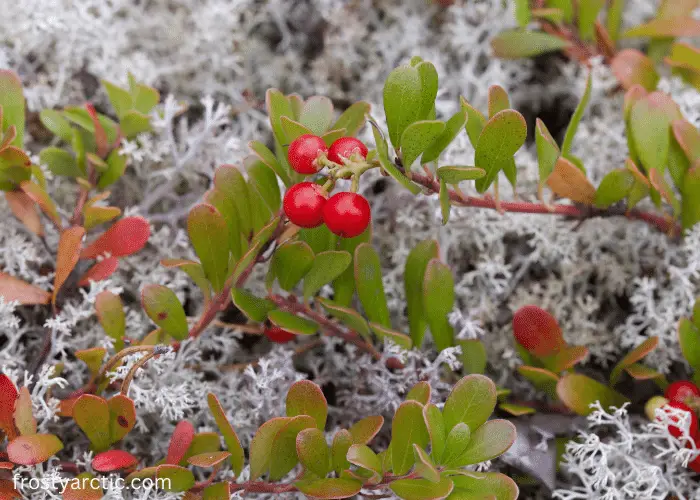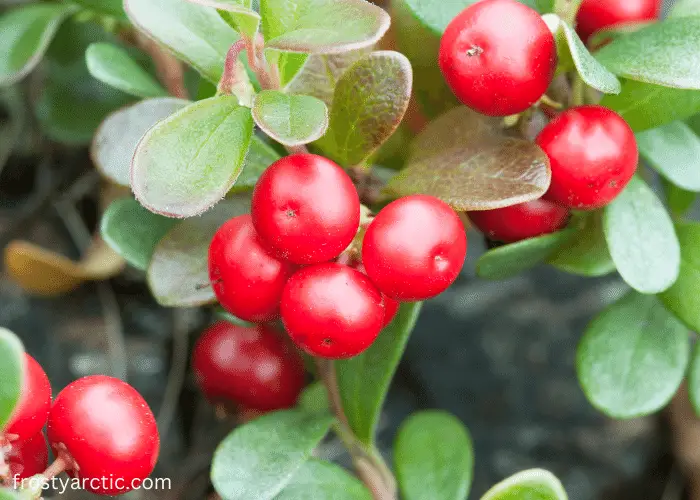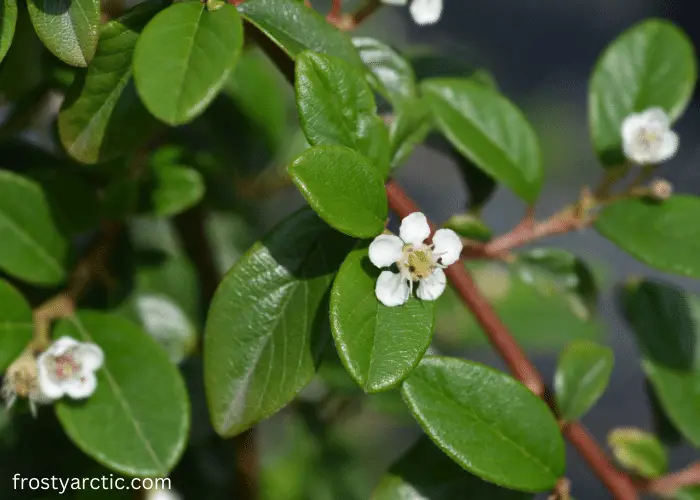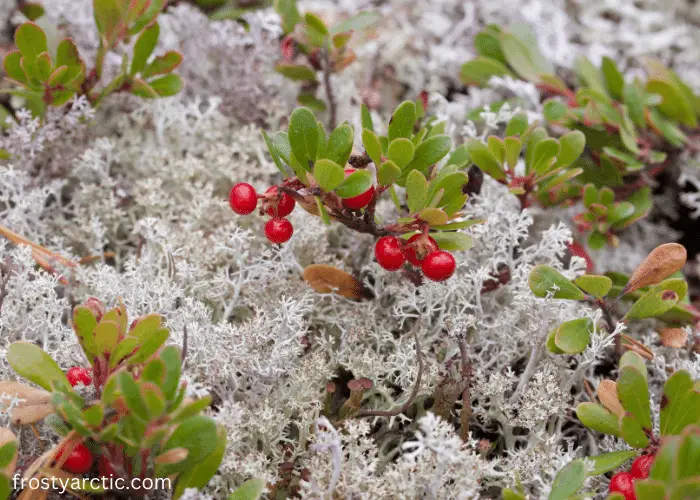Bearberry is arctic or subarctic shrubs or semi-shrubs. It can form attractive dense ground mats where no other plants can survive. Besides, it requires a little care to grow and play a significant role in the food ecosystem of many animals.
You might wonder how bearberry could survive in a place where no other plants can. I will discuss that and its role in the food ecosystem and medical science. Therefore, keep reading to learn more interesting facts about bearberries.
Bearberry at a Glance
| Parameters | Details |
| Scientific name | Arctostaphylos uva-ursi |
| Root type | Rhizome |
| Height | 6-12 inches |
| Soil type | Gravel, Sand, Loam |
| Soil moisture | Dry, medium |
| Soil pH | 4-6 |
| Sun exposure | Full sun, partial |
| Suitable weather | Cold, moderate heat |
| Bloom color | White, Pink |
| Bloom Time | April, May, and June |
| Fruit color | Green, Red, Dark Black |
| Benefits | Host plant, medicinal herb, deer resistant, food of hummingbirds and bears. |
What is Bearberry?
Bearberry is mainly a low-growing sub-shrubs. Its surface rhizomes help it to grow over the ground and cover the ground like a mat. However, this plant has dark green leaves, Flexible streams of tear-drop shape, and trailing shrubs with an alternate.
Interestingly, the dark green foliage doesn’t remain the same all year round. It turns into a dark purplish color in winter, whereas it becomes green again in spring.
Bearberry plants can be 3-6 feet wide. But it can only reach up to the maximum of 6-12 inches high. In the mid-spring, you will find white to pale pink waxy flowers in these plants. You will find a group of red cherry berries that will be 1 cm across.
Why Is It Called the Bearberry?
It is called bearberry because it’s a favorite food of bears. Mainly Polar Bears live on these types of berry plants during the summer season.
Raw bearberry is safe for consumption. It plays a pivotal role in the feeding ecology of bears. These fleshy-fruit plants become their source of food during mid-summer.
Generally, bearberry plants can adapt to cold weather. Thus, these plants are available in the Arctic and sub-arctic regions, making them an available food source for polar bears.
Where Does Bearberry Grow?
Bearberries can grow in a wide range of ground, whether dry, non-nutrient, sand or rocky ground. Also, they can grow both in sunny and shaded places.
It grows better in shady areas as its natural habitat is mountain areas. But it grows better in regions of low temperature to moderate temperature.
It can also grow in sandy or rock-hard lands. But it can’t grow in clay. Besides, it requires well-drained and acidic soil with a pH range between 4.0 to 6.0. Bearberries also grow well in salt soil. Hence, you can also find them beside the beach.

Bearberry mainly grows across mountains and moorlands. This plant is native to North America, Asia, and Europe regions. You can find these plants in Alaska, Canada, Iceland, Greenland, New Mexico, and even in alpine regions like mountains in west Montana.
Can Bearberry Grow in Tropical Areas?
Well, to be honest, bearberries can’t grow well in tropical areas. Though bearberries can grow in sunny places, their natural habitat is a cold region.
In tropical areas, there is no winter, and the temperature remains 18°C or above all year round. Also, the weather is very humid. None of these circumstances are suitable for the proper growth of bearberries.
Bearberry Adaptation
Bearberries can grow in the arctic tundra. Thus, it has specialized adaptation qualities for its survival in cold and windy environments. I will mention several adaptations of bearberries here:
- These plants grow near the ground, and you can even find them growing behind rocks. These kinds of characteristics protect them from the harsh cold and wind.
- Bearberry plants have leathery skin, which helps them to retain moisture in their body. Hence, they don’t get dehydrated easily.
- Their leathery skin also prevents heat transfer from their body. Therefore, their body temperature remains normal throughout the harsh winter as it keeps the heat inside their body.
- Also, silky hairs cover their thick leaves, keeping their bodies warm.

Bearberry Species
Bearberries belong to the genus Arctostaphylos. Bearberries consist of three species of this genus which are alpine, red, and common bearberries.
Alpine Bearberry
The scientific name of this species is Arctostaphylos alpina. It is quite special from other species because it’s not evergreen. Its leaves die during winter, and the berries become dark black color from the initial green color.
Its species include A. Alpina(L.) Spreng(syn. Arctos alpinus (L.)Niedecases. They can form symbiotic relationships with fungi to get essential phosphorus from the soil via fungus. This species is available mainly in Scotland, mountains, and high latitudes.
Red Bearberry
The natural habitat for Red bearberries in southwestern China, east to eastern Siberia, Sichuan, Alaska, northern Canada to northern Quebec. Leaves of red bearberry fall in autumn, leaving the bare stems behind. However, the color of the fruit becomes red when it ripens.
Common Bearberry
This species grows well in dry to moderate moisture. That’s why it can’t grow well in the eastern US, as their weather remains wet and humid during summer.
Naturally, the foliage of these species is of green color but turns into bronze color during winter. It again comes back to its normal color after the winter ends. Berries become from green to red after it ripens.
Bearberry Taste
People can eat bearberries raw or after cooking. You will get two different tastes depending on whether you are eating it raw or cooked.
When you eat it raw, you can’t taste anything as it’s almost tasteless. Also, it’s very dry and mealy in the raw condition. However, cooking brings outs the natural sweetness of bearberries. Thus, if you eat cooked bearberries, you will get a sweet taste like cranberries.
You can also use these bearberries to make jam, jelly, and cool beverages. It can also enhance the flavor and taste of stews and sauces.
What Is the Bearberry Plant Used For?
People use bearberry in a variety of cases. I highly recommend it for curing health problems. Bearberry leaves have considerable value in cosmetic manufacturing as their enzymes help to cure skin problems. But its greatest contribution is in medicine. Its role in curing complex diseases is immense.
Bearberry (Bearberry tea) helps to break down kidney stones by increasing urine and helping to cure arthritis. Reducing headaches is the effect of it. It is also used to reduce body weight.

There are other diseases, like diarrhea, and urinary tract infections, that are cured by bearberry. It keeps our body clean by removing toxins from the kidneys.
What Animals Eat Bearberries?
A wide range of animals eats bearberries. But it is named bearberries because it’s their favorite food.
Mainly birds and small mammals are fond of bearberries. Songbirds, game birds, wild turkeys, and grouse eat bearberries. But do you know they don’t eat some parts of the plants?
A few eat the fruit, whereas others eat the leaves. Birds and bears eat the fruit parts of the plant, and grouse, moose, and sheep eat the leaves. Interestingly, this plant is resistant to deer.
Bearberry for the Skin
Bearberry is very effective for skin whitening. It contains some special skin-whitening ingredients that reduce melanin production in the skin. Arbutin is one of the ingredients found in bearberry that can inhibit the maturation of melanosomes.
It contains a tyrosinase enzyme which reduces the production of melanin. Skin tone becomes naturally bright. It not only brightens skin but also reduces blemishes and dark spots. That is why bearberries are very famous for brightening the skin naturally.
Since bearberry has fewer side effects, it is famous for making skin products. Its popularity is increasing daily for its use in skin whitening, anti-wrinkle, and reducing dark spots. People also use bearberry to formulate moisturizers as it helps hydrate the skin.
What Did Native Americans Use Bearberry For?
Native American use bearberry in a wide range of remedy applications. They first invented the remedy for urinary tract infections from this herb.
- Tobacco: They mix bearberry with tobacco and red willow bark and then mix it with other native herbs to add flavor and suit individual tastes. They use it in a smudge form or smoke in a sacred pipe. This has a vital role in their traditional spirituality.
- Remedy of disease: Native American use bearberry tea as a remedy for UTI, cystitis, kidney stones, and urethritis. Some of them use tea to treat their sprains.
- Reduce swelling: Bearberry leaves have tannin, astringent quality and anti-inflammatory action. Thus, native Americans use this in their sore throat to reduce inflammation.
- Venerable disease: They drink Bearberry drinks or tea to cure venerable diseases and to ward off obesity (Source).
- Urinary System Diseases: They take it as an astringent to treat kidney stones, nephritis, and other urinary tract diseases.
Is Bearberry a Medicinal Plant? Medicinal Use of Bearberry
Yes. Bearberry is a medicinal plant. Only dried leaves are used for making medicine. But the leaves should be collected in green condition and then dried by exposing them to gentle heat.
Its leaves are used to make various ranges of medicine for various health problems. Some of those are as follows.
Medicinal Use of Bearberry
1. Breakdown of kidney stones
Bearberry increases urine production in the kidneys, helping break down kidney stones. As the stones break down, they become smaller and are passed out with urine.
2. Good for pregnant women
Bearberry contains anti-inflammatory properties that can prevent postnatal infections and relieve the discomfort of the mother. It helps prevent miscarriage.
3. Treat Urinary Tract Infection
Bearberry helps to cure urinary tract infections. Bearberry contains an enzyme that is effective in reducing inflammation in the bladder. It gives a soothing sensation to the mucous membrane of the urinary tract, which prevents infection.
4. Help in skin brightening
It has many uses in skin products due to its presence in skin brightening enzymes. Increases skin brightness by reducing melanin and reduces facial blemishes.
5. Quick healing
Bearberry helps the body heal quickly when an injury or a wound occurs. It prevents external infection, used as an ointment for wounds.
6. Helps in losing weight
Those with kidney stones lose weight by removing excess water from their body.
7. Cure headaches
Bearberry is very effective in curing headaches. The narcotic properties contained in bearberry cure headaches.
8. Cure arthritis
Fruit and leaf extracts are applied to the joint. This relieves pain and strengthens muscles.
How Does Bearberry Affect Women with Endometriosis?
Do you know what endometriosis is? It is a medical condition when cells similar to the lining of the uterus grow outside the uterus. Mainly, it grows in ovaries and fallopian tubes.
This can cause problems like painful periods, excessive bleeding, infertility, painful bowel movement, or urination. There are various ways to treat endometriosis, and bearberry is one of them. How do they do so? Let’s see:
Control menstrual symptoms
Bearberry also contains vegetable stearic acids, which are one kind of vegetable saturated fat. Liver enzymes transform this saturated fat into unsaturated fat, which helps to nourish the nervous system.
Do you know that women’s mood swings during the menstrual cycle are related to the nervous system? Bearberry helps reduce the tension of brain cells responsible for menstrual symptoms.
Women with endometriosis go through more severe irritation, tiredness, anxiety, and depression during this period. Bearberries are beneficial in easing those.
Ease bowel movement
Bearberry contains anthraquinone glycosides which act as stimulants in peristaltic actions. Thus, it enhances the smooth muscle contraction and movement of the content through the digestive tract. Therefore, bearberry eases bowel movement, which benefits women with endometrial implants.
Improve digestive system
Bearberries can act as a digestive tonic. It helps in improving the digestive system so that it can efficiently absorb nutrients from foods.
As bearberries can absorb vitamins and can provide them to body cells, it will increase the body’s functions. Menstrual cramp is related to this body function. If one’s body is well-functioned and strong, bearberry can reduce the effect of body cramps.
Eliminate nutrient deficiencies
Most women with endometriosis suffer from a deficiency of a wide range of minerals and vitamins. In this case, bearberry greatly affects the elimination of nutrient deficiency.
This duodenal herb acts as a catalyst in the breakdown of food with enzymes in the small intestine. Bearberry is very helpful in improving the functions of the digestive system. Thus, it can absorb the essential vitamins and minerals from the food source.
Normalize liver disease
Bearberries are capable of normalizing structured liver disease. Do you have any idea how? It helps reduce the catarrh inflammation of the bile duct, resulting in enhanced liver function.
As the liver function increases in protein and fat metabolism, it can balance the hormones of prostaglandins. Thus, the nervous tension also remains balanced, which helps control menstrual cramps and irritation.
FAQ
1. Is the bearberry poisonous?
No. Normally, Bearberries are not poisonous. But, consuming a lot of Bearberries can cause nausea, vomiting, stomach fever, and tinnitus. Therefore, it could be poisonous for pregnant women, people with kidney diseases, and food allergies.
2. What is another name for bearberry?
There are many other names for bearberries, such as crowberry, bear grape, foxberry, hong cranberry, Kinnikinnick, etc.
But its scientific name is Arctostaphylos uva-ursi. This name came from two Greek words, “arctos” and “staphyle,” which mean bear and grape, respectively.
3. Can I eat bearberry?
Yes. Bearberries are edible for humans. It has many medicinal benefits also. But be cautious in eating raw bearberries if you are pregnant or planning to get pregnant. The same applies if you are breastfeeding your baby or suffering from any kidney complications.
4. Which products contain bearberry extract and how do I know there is enough in there?
Various types of natural skin care products contain bearberry extract. You can know the amount of extract if you inspect the color. The light green color and dark color of products indicate a poor amount and pretty quantity of bearberry extract, respectively.
Conclusion
Bearberries are low-growing bushy plants and adapted for survival in harsh weather. That’s why it can grow well in extremely cold weather and non-nutritious soil. Moreover, they also possess many beneficial impacts on health. This is the reason why bearberry plants draw the attention of people.


